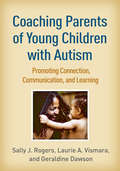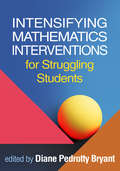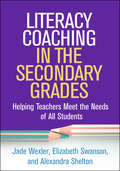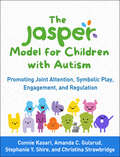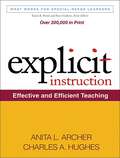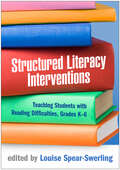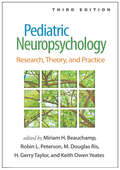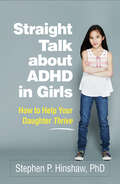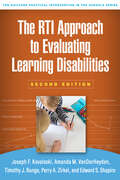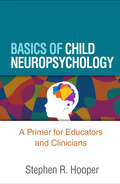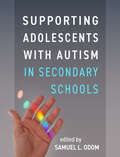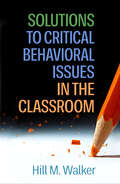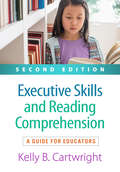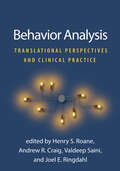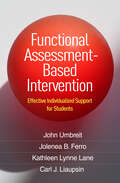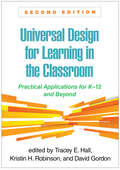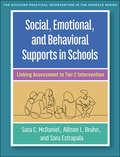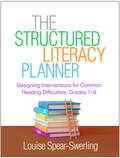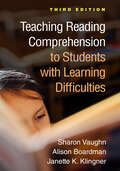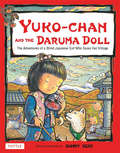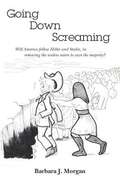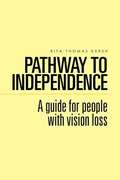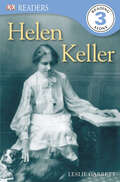- Table View
- List View
Coaching Parents of Young Children with Autism: Promoting Connection, Communication, and Learning
by Sally J. Rogers Laurie A. Vismara Geraldine DawsonA growing body of evidence supports the benefits of high-quality parent interventions for building social and communication skills in 0- to 5-year-olds with autism spectrum disorder (ASD). How can clinicians coach parents to effectively incorporate learning opportunities into daily routines at home? From preeminent experts, this practical book explores the role of the coach and reviews the "whats," "whys," and "how-tos" of successful collaboration with parents. Topics include structuring coaching sessions, identifying children's needs, facilitating playful engagement, and deepening parents' understanding of how they can boost skills development during everyday activities. Seventeen reproducible handouts and forms include the multipage P-ESDM Infant–Toddler Curriculum Checklist, ideal for use in telehealth assessments. Purchasers get access to a Web page where they can download and print the reproducible materials in a convenient 8 1/2" x 11" size.
Intensifying Mathematics Interventions for Struggling Students (The Guilford Series on Intensive Instruction)
by Diane Pedrotty BryantThis key resource for K–12 educators offers a systematic guide to delivering Tier 2 and 3 math interventions within a multi-tiered system of support. The volume explains critical math areas in which many students have difficulty--early numeracy, time and money measurement, number combinations, fractions, word-problem solving, algebra, and more. Leading experts describe relevant standards and show how to use data-based individualization to plan, monitor, and intensify instruction in each area. Beginning with bulleted guiding questions, chapters feature a wealth of evidence-based intervention strategies, lesson-planning ideas, and case examples. Reproducible instructional activities and planning forms can be downloaded and printed in a convenient 8 1/2" x 11" size.
Literacy Coaching in the Secondary Grades: Helping Teachers Meet the Needs of All Students (The Guilford Series on Intensive Instruction)
by Elizabeth Swanson Jade Wexler Alexandra SheltonToo many adolescent learners still struggle with reading. This much-needed guide shows how to support teachers in providing effective literacy instruction in the content areas, which can be intensified as needed within a multi-tiered framework. Adaptive Intervention Model (AIM) Coaching was created for grades 6–8, but is equally applicable in high school. The book gives instructional coaches an accessible blueprint for evaluating, developing, and reinforcing each teacher's capacity to implement evidence-based literacy practices. User-friendly features include case studies, end-of-chapter reflection questions and key terms, and reproducible tools. Purchasers get access to a companion website where they can download and print the reproducible materials--plus supplemental lesson plans and other resources--in a convenient 8 1/2" x 11" size.
The JASPER Model for Children with Autism: Promoting Joint Attention, Symbolic Play, Engagement, and Regulation
by Connie Kasari Amanda C. Gulsrud Stephanie Y. Shire Christina StrawbridgeThis full-color, clinician-friendly manual is the authoritative guide to implementing the Joint Attention, Symbolic Play, Engagement, and Regulation (JASPER) intervention. With a strong evidence base, JASPER provides a clear, flexible structure to bolster early skills core to social communication development. The authors show how to assess 1- to 8-year-olds with autism spectrum disorder (ASD), set treatment targets, choose engaging play materials, tailor JASPER strategies to each individual, and troubleshoot common challenges. In a convenient large-size format, the manual features case examples, learning exercises, and reproducible clinical tools. At the companion website, clinicians can download and print the reproducible materials as well as a supplemental annotated bibliography.
Explicit Instruction: Effective and Efficient Teaching (What Works for Special-Needs Learners)
by Anita L. Archer Charles A. HughesExplicit instruction is systematic, direct, engaging, and success oriented--and has been shown to promote achievement for all students. This highly practical and accessible resource gives special and general education teachers the tools to implement explicit instruction in any grade level or content area. The authors are leading experts who provide clear guidelines for identifying key concepts, skills, and routines to teach; designing and delivering effective lessons; and giving students opportunities to practice and master new material. Sample lesson plans, lively examples, and reproducible checklists and teacher worksheets enhance the utility of the volume. Purchasers can also download and print the reproducible materials for repeated use. Video clips demonstrating the approach in real classrooms are available at the authors' website: www.explicitinstruction.org. See also related DVDs from Anita Archer: Golden Principles of Explicit Instruction; Active Participation: Getting Them All Engaged, Elementary Level; and Active Participation: Getting Them All Engaged, Secondary Level
Structured Literacy Interventions: Teaching Students with Reading Difficulties, Grades K-6 (The Guilford Series on Intensive Instruction)
by Louise Spear-SwerlingComprehensive and evidence-based, Structured Literacy (SL) approaches place a high value on explicit, systematic, and sequential instruction. This book brings together leading experts to present a wealth of SL interventions for different components of literacy. Chapters describe instructional strategies for supporting phonological awareness, basic and multisyllabic word decoding, spelling, reading fluency, vocabulary, oral and reading comprehension, and written expression, especially for at-risk readers and those with disabilities. Including case studies, sample intervention activities, lesson plans, and end-of-chapter application activities, the book contains reproducible tools that can be downloaded and printed in a convenient 8½&“ x 11&” size. An NCTQ Exemplary Text for Reading Instruction See also Louise Spear-Swerling's authored volume, The Structured Literacy Planner: Designing Interventions for Common Reading Difficulties, Grades 1–9, which provides blueprints for tailoring interventions based on a learner's reading profile.
Pediatric Neuropsychology, Third Edition: Research, Theory, and Practice
by Miriam H. Beauchamp, Robin L. Peterson, M. Douglas Ris, H. Gerry Taylor and Keith Owen YeatesRecognized as the definitive reference and text on the relationship between brain health and behavior in children and adolescents, this volume is now in a third edition with 75% new material, including major updates throughout and numerous new chapters. Leading experts provide a neuropsychological perspective on medical, neurological, genetic, and developmental disorders that are frequently seen in clinical practice. The volume examines the impact of each condition on the developing brain; explores associated cognitive, behavioral, and psychosocial impairments; and shows how the science translates into achieving better outcomes for children. New to This Edition *Reflects 12 years of significant research advances and the expanding role of pediatric neuropsychologists; increased attention to evidence-based intervention throughout. *Chapters on additional medical and neurodevelopmental conditions: pediatric stroke, congenital heart disease, type 1 diabetes, and movement disorders. *Section on genetic disorders: fragile X, Williams syndrome, 22q11.2 deletion syndrome, and Down syndrome. *Section on emergent and controversial conditions: nonverbal learning disabilities, dysexecutive syndrome, pediatric acute-onset neuropsychiatric syndrome, and sluggish cognitive tempo.
Straight Talk about ADHD in Girls: How to Help Your Daughter Thrive
by Stephen P. HinshawParenting a daughter with attention-deficit/hyperactivity disorder (ADHD) is no easy path--especially because of the myth that the disorder is rare to nonexistent in girls. From pioneering researcher Stephen P. Hinshaw, this empowering guide provides vital information and advice to help you understand and meet your daughter's needs. Dr. Hinshaw delivers up-to-date facts on what ADHD is, why symptoms often appear differently in girls than in boys, why girls with ADHD behave the way they do, how to get an accurate diagnosis, and what treatments are most effective. There is so much pressure on girls to be "perfect"--and for those with ADHD, it feels especially hard to measure up. Learn concrete steps you can take to support your daughter's success from preschool through high school and beyond, while nurturing her confidence and self-worth.
The RTI Approach to Evaluating Learning Disabilities (The Guilford Practical Intervention in the Schools Series)
by Joseph F. Kovaleski Amanda M. VanDerHeyden Timothy J. Runge Perry A. Zirkel Edward S. ShapiroFrom leading authorities, this indispensable work is now in a revised and expanded second edition, presenting state-of-the-art tools and procedures for practitioners. The book shows how to use response to intervention (RTI) to evaluate K–12 students for specific learning disabilities (SLD). The second edition gives increased attention to optimizing the instructional environment in the context of a multi-tiered system of supports (MTSS). Procedures are described for screening at-risk students; using RTI to intensify instruction in reading, writing, and math; identifying SLD; determining eligibility for special education; and planning individualized education programs. Case examples and pointers for practice are woven throughout. In a convenient large-size format, the book includes reproducible tools that can be downloaded and printed for repeated use. New to This Edition *Incorporates contemporary perspectives on SLD, upgraded procedures for implementing an MTSS, new approaches to measuring RTI, and enhancements in using classroom observations. *Chapter on best practices in academic screening, including important dos and don'ts. *Separate chapters on using RTI for reading, written expression, and mathematics. *Chapter on RTI and special education law, focusing on what practitioners need to know. This book is in The Guilford Practical Intervention in the Schools Series, edited by Sandra M. Chafouleas.
Basics of Child Neuropsychology: A Primer for Educators and Clinicians
by Stephen R. HooperWritten expressly for non-neuropsychologists, this book offers a concise, friendly introduction to the developing brain and its functions. Stephen R. Hooper renders complex concepts accessible as he describes the structure of the brain and the workings of the nervous system. The book explains how findings from neuropsychological assessments can help educators and clinicians to better understand and remediate children's difficulties. A range of neurodevelopmental and medical conditions that affect learning and behavior from early childhood through adolescence are explored through a neuropsychological lens. Helpful features include key Take-Home Points distilled from the chapters and recommended print and online resources.
Supporting Adolescents with Autism in Secondary Schools
by Samuel L. OdomIn a convenient large-size format, this book presents the first research-based, comprehensive program designed to support high school students with autism spectrum disorder (ASD). Developed and tested in public schools by the Center on Secondary Education for Students with Autism Spectrum Disorder (CSESA), the program addresses four critical areas--literacy, social competence and peer relationships, independence, and postschool transition preparation for students and their families. Chapters provide a roadmap for implementation of each component, complete with intervention guidelines, case vignettes, key findings, lessons learned, and reproducible forms that can be downloaded and printed at the companion website. The book also helps readers navigate the wealth of additional resources freely available from CSESA.
Solutions to Critical Behavioral Issues in the Classroom
by Hill M. WalkerThis highly practical reference is organized around the problem behaviors that K–6 teachers see as the greatest barriers to student success--and the positive behaviors they value the most. Of particular value to educators, the book matches proven intervention techniques to specific target behaviors. Hill M. Walker presents exemplary strategies for managing such classroom challenges as defiance, low motivation, and aggression. He also reviews ways to build all students' skills for following directions, staying on task, coping with frustration, getting along with peers, and more. The book includes illustrative case examples and a section that clearly explains key principles of behavior management. Reproducible handouts and forms can be downloaded and printed in a convenient 8 1/2" x 11" size.
Executive Skills and Reading Comprehension: A Guide for Educators
by Kelly B. CartwrightThis pioneering book is now in a revised and expanded second edition featuring the latest neuroscientific knowledge and instructional strategies. Kelly B. Cartwright provides a teacher-friendly explanation of executive skills--such as planning, organization, cognitive flexibility, and impulse control--and their role in reading comprehension. Detailed examples illustrate how each skill is deployed by strong comprehenders and ways to tailor instruction for students who are struggling. The companion website features reproducible planning and assessment forms from the book as well as supplemental card sorts to teach and assess cognitive flexibility, all ready to download and print in a convenient 8 1/2" x 11" size. New to This Edition *Updated throughout with advances in theory, research, and instruction. *Chapter on word recognition, with particular attention to dyslexia. *Information on the development of the brain's reading network. *Expanded emphasis on oral language comprehension. *Appendix of intervention studies; online-only supplement with card sorts to teach and assess cognitive flexibility.
Behavior Analysis: Translational Perspectives and Clinical Practice
by Henry S. Roane Andrew R. Craig Valdeep Saini Joel E. RingdahlThis is the first comprehensive volume to bridge the gap between the science of behavior and applied behavior analysis (ABA). The book demonstrates how laboratory research informs real-world interventions to facilitate behavior change, and vice versa. Most of the chapters are written by researcher–clinician collaborators, who highlight commonalities and differences in the ways they conceptualize behavior and collect, analyze, and use data. Chapters present translational perspectives on conditioning, reinforcement, extinction, choice, verbal behavior, and more. Ethical considerations in translational research are explored. Training in foundational knowledge is a key requirement for behavior analyst certification, making this a needed resource for current and future ABA practitioners.
Functional Assessment-Based Intervention: Effective Individualized Support for Students
by John Umbreit Jolenea B. Ferro Kathleen Lynne Lane Carl J. LiaupsinFrom noted authorities, this book presents a comprehensive approach to designing and implementing evidence-based Tier 3 behavior interventions for K–12 students. The authors' functional assessment-based intervention (FABI) process has been supported by multiple peer-reviewed studies conducted in authentic educational environments. Step by step, chapters spell out proven methods to define target behaviors, determine the function of the undesirable behavior, identify appropriate replacement behaviors, and deliver and monitor intensive interventions. Illustrated with real-world case examples, the book shows how to embed FABI within a school's integrated tiered system of supports. Guidance for scaling FABI district- and statewide is also provided. Ethical issues, professional standards, equity concerns, and cultural and linguistic considerations are addressed throughout. In a convenient large-size format, the book includes reproducible checklists and forms that can also be downloaded for ease of use.
Universal Design for Learning in the Classroom: Practical Applications for K-12 and Beyond
by Tracey E. Hall Kristin H. Robinson David GordonThe Universal Design for Learning (UDL) framework has grown from its origins in special education to being widely used to support all students, making the fully rewritten second edition of this indispensable guide more relevant than ever. Filled with practical, vivid examples and tips, the book demonstrates the power of UDL when applied to particular content areas. Specific teaching ideas are presented for literacy, STEM, project-based learning, career and technical education, and the arts. The editors and contributors describe practical ways to create thriving learning environments that use UDL to meet diverse learners' needs. New to This Edition *Entirely new content. *Coverage expanded from elementary and middle grades to secondary and beyond. *Innovative approaches embracing the growth of UDL and the ubiquity of digital technologies in today&’s classrooms. *Spotlight on issues of equity and inclusion. *Chapters on antiracism, social–emotional learning, career and technical education, journey mapping, and curriculum design. *Compelling discussions of advances in UDL principles and research directions.
Social, Emotional, and Behavioral Supports in Schools: Linking Assessment to Tier 2 Intervention (The Guilford Practical Intervention in the Schools Series)
by Sara C. McDaniel Allison L. Bruhn Sara EstrapalaMeeting a critical need, this accessible guide addresses the "whats," "whys," and "how-tos" of developing and implementing effective Tier 2 social, emotional, and behavioral supports. The book provides explicit steps for identifying K–12 students who could benefit from Tier 2, matching evidence-based interventions to student needs, and making individualized, data-based decisions regarding adapting, fading, or intensifying supports. Chapters review exemplary interventions in the areas of conduct, self-regulation, social issues, emotional issues, and co-occurring academic and social–emotional–behavioral needs. The place of Tier 2 in schoolwide positive behavioral interventions and supports (PBIS) is explained, and keys to implementation fidelity are highlighted. In a large-size format for easy photocopying, the book includes 23 reproducible forms and checklists that can also be downloaded and printed. This book is in The Guilford Practical Intervention in the Schools Series, edited by Sandra M. Chafouleas.
The Structured Literacy Planner: Designing Interventions for Common Reading Difficulties, Grades 1-9
by Louise Spear-SwerlingStructured Literacy (SL) approaches are increasingly recognized as the gold standard for teaching struggling readers. This highly practical book walks educators through designing SL interventions for students with common types of reading difficulties--word reading, comprehension, or a combination of both. Louise Spear-Swerling offers tools for assessing students' reading profiles and tailoring SL to their needs. In a convenient large-size format, the volume is packed with case studies, sample lesson plans addressing both early and advanced stages of reading, instructional activities, and application exercises for teachers. A chapter on English language structure presents essential foundations for implementing SL effectively. The companion website features a knowledge survey about language structure (with answer key), as well as downloadable copies of the book's 14 reproducible forms. See also Louise Spear-Swerling's edited volume, Structured Literacy Interventions: Teaching Students with Reading Difficulties, Grades K–6, which surveys SL interventions across all components of literacy.
Teaching Reading Comprehension to Students with Learning Difficulties (The Guilford Series on Intensive Instruction)
by Sharon Vaughn Janette K. Klingner Alison BoardmanNow in a revised and expanded third edition, this important resource helps teachers understand how good readers comprehend text and how best to support students who are struggling. It presents effective instructional methods for learners at all grade levels, including those with reading disabilities. Every chapter translates state-of-the-art research into practical classroom applications. All facets of comprehension are addressed, including assessment, vocabulary, background knowledge, and text structure. Chapters also cover English learners, intensive intervention, and content literacy. Utility as a teacher guide and course text is enhanced by sample lesson plans, graphic organizers, and chapter-opening study questions. New to This Edition *Chapter on text selection and text structure. *Chapter on teachers' frequently asked questions, providing specific, actionable advice. *More than twice as many sample lesson plans. *Revised throughout with the latest research and teaching techniques.
Yuko-chan and the Daruma Doll: The Adventures of a Blind Japanese Girl Who saves Her Village
by Sunny SekiYuko-chan and the Daruma Doll, a gorgeous multicultural children's book by author/illustrator Sunny Seki, takes readers on a journey into ancient Japan and the story behind the famous Daruma Doll.<P><P>Yuko-chan, an adventurous blind orphan, is able to do amazing things. She confronts a burglar in the dead of night, and crosses treacherous mountain passes to deliver food to hungry people. During her travels, Yuko-chan trips and tumbles down a snowy cliff. She discovers a strange thing as she waits for help: her tea gourd, regardless of how she drops it, always lands right-side-up. The tea has frozen in the bottom of the gourd! Inspired by this, she creates the famous Daruma doll toy, which rights itself when tipped--a true symbol of resilience.Thanks to Yuko-chan's invention, the villagers are able to earn a living and feed themselves by selling the dolls. Yuko-chan never gave up, no matter the obstacles she faced, and the Daruma doll is a charming reminder of the power of perseverance.
Going Down Screaming: Will America Follow Hitler and Stalin, In Removing the Useless Eaters To Save The Majority?
by Barbara J. MorganA history of the nursing home industry, coupled by a short history of the school system. There two events are the crux of the story describing the elderlly and their values, the young and their lack of values. Subsequently when the crises of America comes to fore, (too many seniors, too few young)the outcome of life for the elderly will be determined by the children of today. It can only end in euthanasia. The lack of sufficient young to pay the bills for the elderly was created by the abortion act in Roe vs Wade, which ironically enough is now working against those who agreed to the abortion law, and now are dependent on that low census generation to spare them.
Life Rolls On (2nd Edition)
by Rich Ochoa Duane HaleWhen he was four years old, doctors told Duane Hale's parents that their son had Spinal Muscular Atrophy and that he wouldn't live past his teens. That was forty-two years ago and he has now outlived some of those doctors. What happens to a rambunctious little boy whose disease turns him into a man who can't move? How does such a man graduate high school as Student of the Year, work twenty years for the police department, buy a house, get married, father and raise a son?This is the story of a man and the strength he derives from his family and his community. Even as the disease paralyzes more of his body every day his spirit stays strong and Life Rolls On.
Pathway to Independence: A Guide for People with Vision Loss
by Rita Thomas KershMany helpful hints for people with severe vision loss or blindness.
DK Readers L3: Helen Keller (DK Readers Level 3)
by Leslie GarrettIn this new Level 3 Reader, the captivating story of Helen Keller unfolds. Children able to read on their own will be eager to delve in, learning more about Helen's life, from her early days as a deaf and mute infant, to those as an adult who achieved great academic success in spite of her challenges.
DK Readers L3: Helen Keller (DK Readers Level 3)
by Leslie GarrettIn this new Level 3 Reader, the captivating story of Helen Keller unfolds. Children able to read on their own will be eager to delve in, learning more about Helen's life, from her early days as a deaf and mute infant, to those as an adult who achieved great academic success in spite of her challenges.
